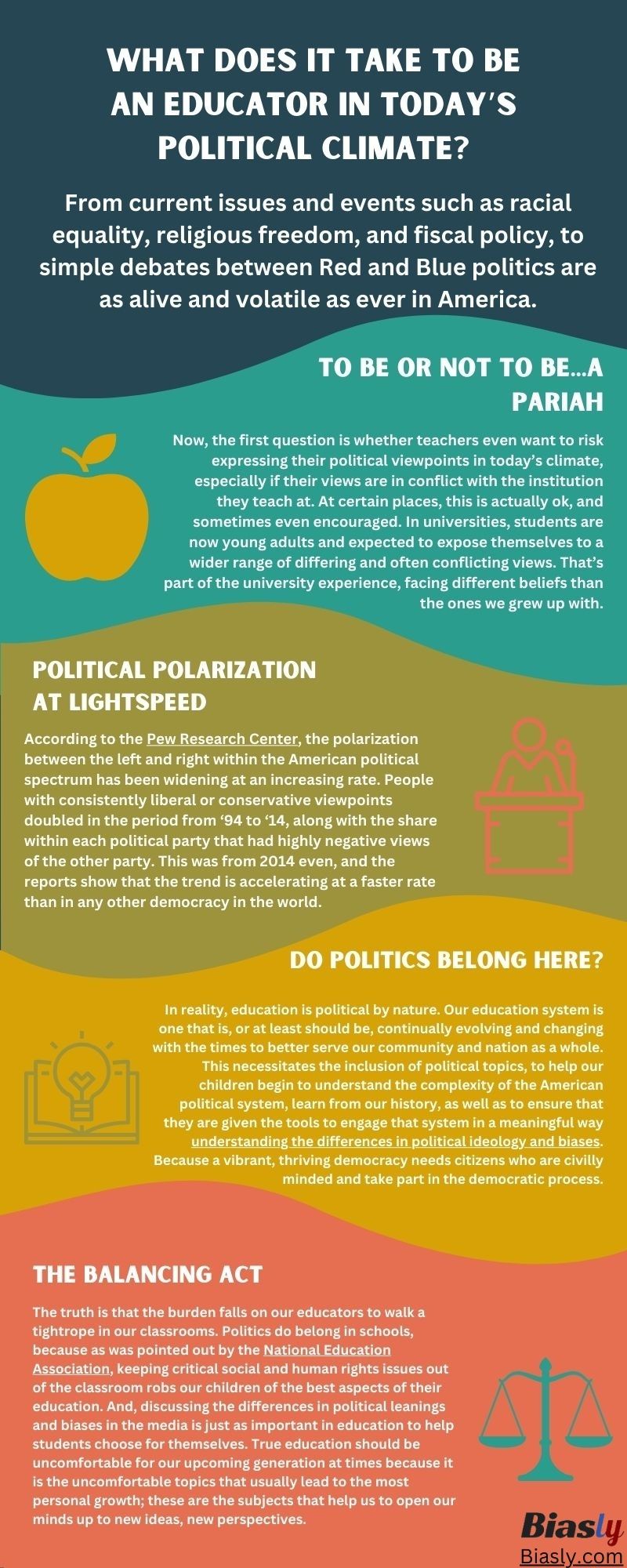
From current issues and events such as racial equality, religious freedom, and fiscal policy, to simple debates between Red and Blue politics are as alive and volatile as ever in America.
Where do educators fall in this jumbled political system that has been formed over nearly two and a half centuries? Or rather how should they fall? America is built on foundational principles of political freedom, and the right to express our minds without fear of retaliation. But as most educators are employees of the state itself, and partly responsible for shaping the young minds of our children, there is a reasonable expectation that they do not push their own political leanings in schools. So how do our teachers balance these seemingly opposing values?
To Be or Not to Be…. a Pariah
Now, the first question is whether teachers even want to risk expressing their political viewpoints in today’s climate, especially if their views are in conflict with the institution they teach at. At certain places, this is actually ok, and sometimes even encouraged. In universities, students are now young adults and expected to expose themselves to a wider range of differing and often conflicting views. That’s part of the university experience, facing different beliefs than the ones we grew up with.
But what about in high school, or even elementary school? I myself grew up in a rather conservative small town, and I recall my fifth grade teacher being a fairly ardent supporter of Al Gore during the 2000 election. While she was not particularly loud or expressive about her political positions and I was not overly interested in politics at the time, I can still recall a certain amount of awkwardness she received from the other teachers in the school. And that was back then.
Political Polarization at Lightspeed
According to the Pew Research Center, the polarization between the left and right within the American political spectrum has been widening at an increasing rate. People with consistently liberal or conservative viewpoints doubled in the period from ‘94 to ‘14, along with the share within each political party that had highly negative views of the other party. This was from 2014 even, and the reports show that the trend is accelerating at a faster rate than in any other democracy in the world.
There are a number of reasons speculated concerning this, ranging from changes within the Democratic and Republican parties, homogenizing and polarizing in their ideologies and positions, to media bias from the various major conglomerates pushing and influencing those who listen to them to continue the process of polarization. Whatever the reasons, America appears to be growing more and more conflictual across the aisle, and there doesn’t seem to be anything about it that’s going to change in the near future. With this ever-increasing divide in the American political scene, what place, if any, does politics have in our education system?
Do Politics Belong Here?
Many might debate that, in light of how polarized America is, politics has no place in education. And there is a solid argument to be made here. With the freedom of speech and religion being some of the founding principles of our nation, it could be said that public, state-funded education has no right to include any political topics within its curriculum and that educators themselves should avoid these kinds of issues like the plague itself, both to avoid the controversy, as well as influencing students with their own biases.
However, in reality, education is political by nature. Our education system is one that is, or at least should be, continually evolving and changing with the times to better serve our community and nation as a whole. This necessitates the inclusion of political topics, to help our children begin to understand the complexity of the American political system, learn from our history, as well as to ensure that they are given the tools to engage that system in a meaningful way understanding the differences in political ideology and biases. Because a vibrant, thriving democracy needs citizens who are civilly minded and take part in the democratic process.
The Balancing Act
The truth is that the burden falls on our educators to walk a tightrope in our classrooms. Politics do belong in schools, because as was pointed out by the National Education Association, keeping critical social and human rights issues out of the classroom robs our children of the best aspects of their education. And, discussing the differences in political leanings and biases in the media is just as important in education to help students choose for themselves. True education should be uncomfortable for our upcoming generation at times because it is the uncomfortable topics that usually lead to the most personal growth; these are the subjects that help us to open our minds up to new ideas, new perspectives.
At the same time, parents do have a right to expect teachers not to push their own personal political beliefs and convictions onto their students, influencing them to change their political alignments and leanings, possibly going against strong family, sometimes even religious, values.
So in the end, the teacher must create a delicate balance, broaching sensitive political subjects in the classroom, encouraging critical thinking on the students’ part, all while avoiding undue influence on the students’ minds. They have to ask the hard questions, get the students’ minds really thinking and look at things in a new way, without telling them what to think about the various political landmines that dot the American landscape today.
In the end, that is what education is supposed to be about; providing students with the tools to find the answers for themselves, not just giving them those answers. This can be done through Biasly’s Media Literacy Education Platform (MLEP) platform that teaches and trains students how to analyze and discover political issues and biases in the media for themselves.























